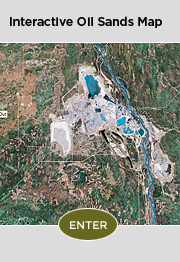The Other Oil Sands
Close your eyes and think for a moment of the oil sands. What do you see? Giant shovels? Heavy haul trucks?
If these are the images that come to your mind’s eye, you are thinking of oil sands mining. But, what is not widely recognized is only 20 per cent of the recoverable oil sands resources are shallow enough to be mined. And those mineable barrels lie under only 2.5 per cent of the overall land area of the oil sands.
Mining is a critical component of the oil sands story that will produce oil for decades to come. But as you will see, it is not the whole story.
The other side of the story is the 80 per cent of the resource known as in-situ oil sands production. In-situ production (or drillable oil sands production) is used to recover deposits that are located more than 75 metres underground. Most in-situ bitumen production comes from deposits buried more than 400 metres below the surface of the earth.
Steam-Assisted Gravity Drainage (SAGD) is currently the predominant in-situ recovery method in the Athabasca region which works by injecting steam through long horizontal injection wells. The thick bitumen is heated so that it is able to drain by gravity to production wells below the injection well and then be pumped to the surface.
There are, however, many other technologies being tested today focused around decreasing water and energy use - and, hence, Greenhouse Gas (GHG) emissions - while increasing bitumen recovery efficiency.
Just one example of this is Suncor’s Zero Liquid Discharge (ZLD) Process at its MacKay River in-situ facility. Among ZLD’s benefits is its water recycling rates of 96 per cent, meaning the MacKay River facility needs very little water from nearby aquifers for its operation.
Another good example is Petrobank’s THAI® or Toe-To-Heel Air Injection technology.
THAI® creates underground combustion to liquefy and produce the bitumen with emissions staying trapped underground. THAI® has the potential to recover 70 to 80 per cent of the bitumen in-place, uses little fresh water and emits 50 per cent less GHG emissions.
The electric stimulation process enables low-cost recovery of stranded oil reserves by applying electric currents to hydrocarbons in the ground. This process upgrades and mobilizes heavy oils that are too viscous to be extracted by conventional techniques. E-T Energy has plans to begin production in 2012 starting with 10,000 barrels per day.
What makes the oil sands so valuable to all of us from an economic perspective is the substantial amount of R&D, expertise, specialized skills, engineering and support services that go into creating these oil sands technologies.
This is not conventional oil production, which can be done for just a few dollars a barrel in the giant oil fields of the Middle East. This is technically difficult and costly, with some projects needing oil prices above $50 a barrel to break even. That complexity, though, is good for economic development.
The in-situ segment of the industry is expected to grow substantially in the next few decades. There is currently around $12 billion worth of new in-situ facilities under construction, $23 billion with regulatory approval and $132 billion in the development process.
Oil sands development is one of the largest industrial projects ever undertaken in Canada. And as in-situ production becomes the next “conventional-unconventional oil”, its economic impacts will continue to grow even as its environmental footprint continues to decline.
For more information on current oil sands in-situ projects visit the OSDG project status.




















